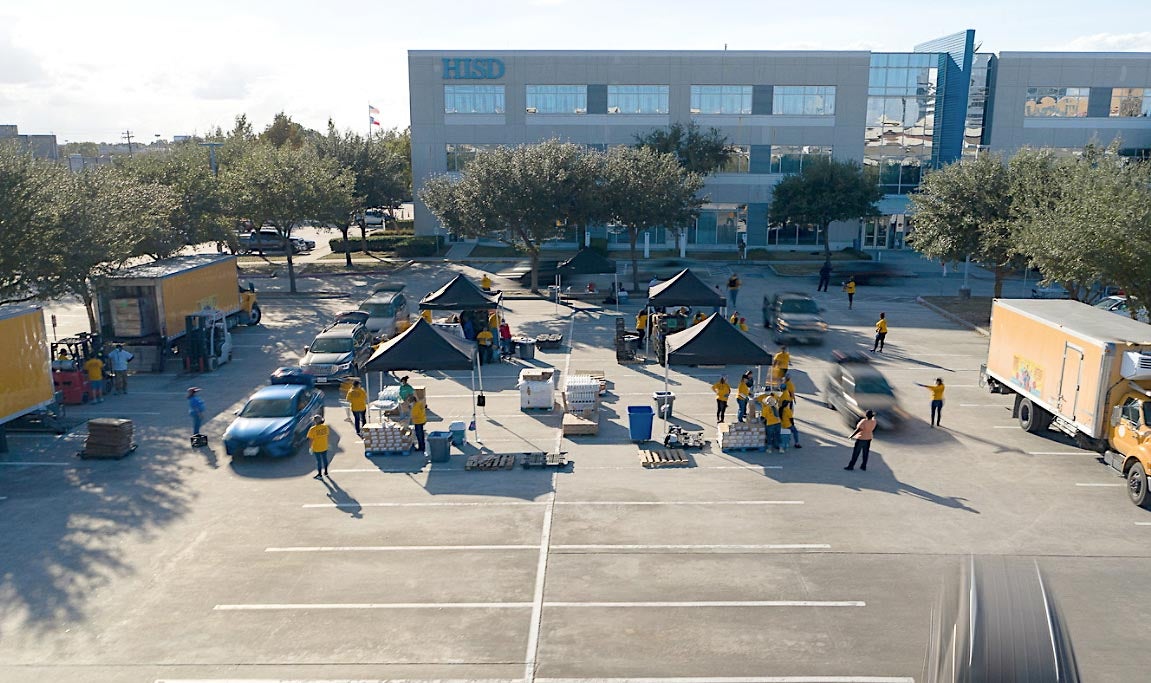School district instructional plans described very different approaches to schooling during the pandemic, and while all schools shifted to online instruction, how that online instruction was offered varied. Despite the variability in instruction, a common feature of these plans were discussions about educating students from special populations like English learners and special education students. The attention district plans gave to serving their least advantaged students tended to focus on educational needs, while extra-educational supports and resources, such as food services, were not fully addressed.
Inconsistent logistics
All district plans described a shift to online instruction, but how that instruction was delivered varied significantly and often included more than one instructional format.
About 70% of plans described synchronous instruction, meaning teachers would meet with students in real-time, conducting class similar to how it was happening in-person but now within a virtual classroom.
Nearly 60% of district plans described an option for learning asynchronously, such as having teachers pre-record a lesson or lecture, posting it to the class website where students could view it on their own, and follow-up with the teacher via online chat or email with questions.
Several other instructional options were described in district plans. With individual district plans often containing multiple instructional options, it created a flexible learning environment but also one with inconsistencies within a district, and even within individual campuses. District plans often justified having numerous instructional options as a way to provide teachers with flexibility, with the goal of minimizing teacher burnout and maximizing options for students staying engaged.

Equitable thinking
The vast majority of school districts’ plans specifically called out a need to serve and support special populations of students during the pandemic. These populations included students who had previously received specific services (e.g., special education students, English learners) and students confronted with persistent and consistent challenges from systemic inequality (e.g., students living in poverty, students of color). More than three-quarters of district plans included guidance for how to continue to serve special education students during the switch to virtual instruction, and over half contained strategies on how to best support English learners.
Many plans acknowledged the way the shift to online instruction highlighted long-standing inequities in students’ access to technology. District plans expressed concern that students from lower socioeconomic circumstances wouldn’t have a suitable device for accessing instructional material, or access to high-speed internet to stream real-time teaching. More than 7 in 10 district plans included steps the district intended to take in order to provide students with access to the technology, such as expanding Wi-Fi compatible areas and establishing partnerships with providers to increase the availability of devices and internet access at home.
About 2 out of every 3 district plans also proposed increased technological support services for teachers and students. These increased supports included hiring more IT support personnel and providing more online resources for parents/students.

Houston ISD distributed 44 million pounds of food and household supplies and served more than 8.9 million meals during its food service outreach program in 2020-2021. (Courtesy Houston ISD)
Other necessities
The pandemic exacerbated pre-existing inequalities, such as food insecurity and mental health, which were factored into most school district plans. Around 70% of plans mentioned mental health support for students, while around half provided guidance on food support to students. Among plans that did call out providing meals to students, distribution strategies differed. About 10% of plans described delivery plans that would take food directly to students’ homes, and more frequently, almost 50% of plans called for setting up food distribution sites.
The digital environment meant some students could become unreachable, either by choice or by circumstance. But, only a quarter of district plans included contingencies if students were completely unresponsive.

What about teachers?
Despite switching to a completely online learning environment, only about half of school district plans mentioned any form of teacher training (i.e., best practices for distance learning, how to record online lessons, or using online tools).
And, while district plans often pointed to additional supports and services that students needed, less mention was made of supports and services for teachers. Only 20% of plans mentioned the same sort of mental health support for teachers that was offered to students.
Going forward
The American Rescue Plan (ARP) Elementary and Secondary School Emergency Relief fund has allocated billions of dollars to primary and secondary education in the United States with the explicit purpose to “safely reopen and sustain the safe operation of schools and address the impact of the coronavirus pandemic on the Nation’s students.”
Using the data from this report, school districts should 1) allocate significant ARP funds toward future pandemic planning measures, and 2) prepare safety measures and other necessary investments for the fall of 2021 and variants of the COVID-19 virus.
The pandemic also created investment in digital infrastructure at an unprecedented rate. This digital infrastructure—laptops, internet hotspots and software—will last well beyond the pandemic, creating a new platform for learning that has attempted to bridge the digital divide. New styles of learning were explored such as pre-recorded classes and self-directed learning, which are starkly different from face-to-face learning. Whether digital learning is a viable option for student learning and achievement going forward is yet to be determined, and future research would be valuable in evaluating the effectiveness of these online learning methods.
School districts around the country confronted an unprecedented interruption to education in the spring 2020, and within a matter of weeks developed plans for how to continue schooling in the fundamentally altered setting. The result of those plans showed districts having very different strategies for how to conduct schooling, but also with overlap in the special populations that needed additional attention and services. Moving forward, planning for a future pandemic or other emergencies should leverage the lessons learned from COVID-19 and its disruptions to schooling.
Jake Joseph is an undergraduate research assistant with the Houston Education Research Consortium.

